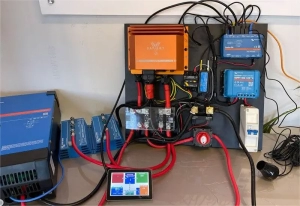Ignite Your Knowledge: Lifepo4 Battery Voltage Guide 2023
Table of Contents
- Ignite Your Knowledge: Lifepo4 Battery Voltage Guide 2023
- 1. Understanding the Lifepo4 Battery Voltage Chart
- 2. A Closer Look at the 12V Lifepo4 Battery Voltage Chart
- 3. Deciphering the 24V Lifepo4 Battery Voltage Chart
- 4. Exploring the Concept of Nominal Voltage in Lifepo4 Batteries
- 5. Understanding the Lifepo4 Battery Voltage vs. Capacity Correlation
- 6. Demystifying Fully Charged Lifepo4 Battery Voltage

1. Understanding the Lifepo4 Battery Voltage Chart
1.1 Introduction
Welcome aboard as we unravel the Lifepo4 battery voltage chart. Think of this chart as a secret decoder ring. It plots battery voltage against the state of charge (SoC). This visual representation provides a quick glimpse into the remaining juice in your battery at a given voltage.1.2 A Snapshot of Voltage and SoC
Let's get into the specifics. Picture a line graph. On the Y-axis, we have the battery voltage. The X-axis shows us the State of Charge (SoC) in percentages. As the voltage drops from its peak, the SoC also decreases. This shows that as you use up the energy in your battery (decreasing SoC), the voltage also declines.Let's put some numbers on that chart for context. For a standard Lifepo4 battery:| Voltage | State of Charge (SoC) |
|---|---|
| 3.65V | 100% |
| 3.45V | 75% |
| 3.30V | 50% |
| 3.20V | 25% |
| 2.50V | 0% |
1.3 Voltage Variations and Your Battery
What does this chart mean for you? When your battery voltage reads 3.65 volts, congratulations, you have a fully charged battery! As you start using your electric vehicle or device, the voltage will decrease. When you hit around 3.3 volts, you've used about half of your battery's energy. If you see your voltage at 2.5 volts, stop! Your battery is effectively empty.You now hold the keys to your Lifepo4 battery kingdom! You can maximize the longevity and performance of your battery by using this chart to avoid deep discharges. So, power up, and enjoy the ride!2. A Closer Look at the 12V Lifepo4 Battery Voltage Chart
2.1 2V Lifepo4 Battery Voltage Chart: The Basics
Unleash the power of knowledge by understanding the 12V Lifepo4 battery voltage chart. Just like its sibling we discussed earlier, this chart is a simple tool that translates voltage readings into a battery's state of charge (SoC). It's a key element for Lifepo4 battery users to ensure optimal performance.2.2 Mapping Voltage to State of Charge
In the realm of 12V Lifepo4 batteries, the voltage chart acts like a compass, guiding users about the battery's energy status. Let's visualize the chart as a line graph. The Y-axis shows battery voltage, and the X-axis displays the SoC, expressed in percentages.To make it more tangible, here are some numbers:| Voltage | State of Charge (SoC) |
|---|---|
| 14.6V | 100% |
| 13.8V | 75% |
| 13.2V | 50% |
| 12.8V | 25% |
| 10.0V | 0% |
2.3 Voltage Chart in Real Life
So how does this chart come into play in real life? At a full charge, your 12V Lifepo4 battery will show around 14.6 volts. As you start using your battery-powered device, the voltage starts to dip. When you've consumed around half of your battery's capacity, the voltage will be around 13.2 volts. If the voltage goes down to 10.0 volts, it's time to recharge as your battery is essentially drained.By keeping this chart handy, you can ensure your battery's health by preventing over-discharging, thus increasing its lifespan. You're now ready to ride into the sunset, fully armed with insights from your 12V Lifepo4 battery voltage chart!3. Deciphering the 24V Lifepo4 Battery Voltage Chart
3.1 24V Lifepo4 Battery Voltage Chart: A Quick Introduction
Next, let's turn our gaze to the 24V Lifepo4 battery voltage chart. Just like the 12V one, this chart shows how voltage ties with the battery's state of charge (SoC). This chart is like a treasure map. It guides us to use the battery smartly and prolong its life.3.2 Decoding Voltage and SoC
Imagine the 24V Lifepo4 battery voltage chart as a picture. The voltage is on the Y-axis, and the SoC is on the X-axis. This picture tells us how much energy is left in the battery.Let's take a look at some numbers to illustrate this:| Voltage | State of Charge (SoC) |
|---|---|
| 29.2V | 100% |
| 27.6V | 75% |
| 26.4V | 50% |
| 25.6V | 25% |
| 20.0V | 0% |
3.3 Applying the Chart
Now, let's see this chart in action. When your 24V Lifepo4 battery is fully charged, it will read around 29.2 volts. As you use your device, the voltage drops. When you've used up about half the battery's energy, the voltage will be close to 26.4 volts. If the voltage dips to 20.0 volts, your battery is almost empty. Time to recharge!With this handy chart, you can avoid draining your battery completely. This can help to increase your battery's lifespan. Well, it's time to power up your device and go! And remember, the 24V Lifepo4 battery voltage chart is your friend. It helps you get the best from your battery.4. Exploring the Concept of Nominal Voltage in Lifepo4 Batteries
4.1 Nominal Voltage in Lifepo4 Batteries: The Basics
Let's take a step back. Before we dive into charts and numbers, let's talk about nominal voltage. What is it? It's like the battery's name tag. It gives us a quick idea of the battery's power.4.2 Unpacking Nominal Voltage
The nominal voltage of a battery is its average voltage when it's discharging. For Lifepo4 batteries, the nominal voltage is usually around 3.2 volts per cell. Why 3.2 volts? That's just how this type of battery behaves. It's like a battery's DNA.To put it into context, let's consider a 4-cell Lifepo4 battery. Each cell has a nominal voltage of 3.2 volts. So, if you multiply 3.2 volts by 4, you'll get a total nominal voltage of 12.8 volts for the battery.4.3 Nominal Voltage and Battery Use
Understanding nominal voltage is vital for safe and efficient battery use. For example, if a device requires 12V power supply, a 4-cell Lifepo4 battery is an excellent choice. This battery's nominal voltage matches the power requirement of the device. It's a perfect fit!Keep in mind that nominal voltage isn't the same as the fully charged voltage or the fully discharged voltage. It's the average value during discharge. In essence, nominal voltage is like a battery's middle name. It tells us more about the battery's character and how it works.4.4 Conclusion
In short, nominal voltage is a key player in the battery world. It helps us understand how much power a battery can deliver. When choosing a Lifepo4 battery, always check the nominal voltage. Make sure it matches your device's power needs. That's the key to a smooth and efficient power supply. With this knowledge, you're one step closer to becoming a Lifepo4 battery expert! Keep going!5. Understanding the Lifepo4 Battery Voltage vs. Capacity Correlation
5.1 Lifepo4 Battery Voltage vs. Capacity: The Basics
Voltage and capacity are like two sides of a coin in the battery world. But, how do they connect in a Lifepo4 battery? Let's break it down.5.2 Breaking Down Voltage and Capacity
Voltage is the force that pushes electric energy in a circuit. Capacity, on the other hand, measures the total amount of energy that a battery can store. It's like a battery's fuel tank.In a Lifepo4 battery, the nominal voltage is around 3.2 volts per cell. That's the force part. The capacity, measured in ampere-hours (Ah), is the fuel tank part. A battery with a larger capacity can power a device for a longer period.5.3 How Voltage and Capacity Connect
Now, here's the key part. The relationship between voltage and capacity isn't a simple straight line. It's more like a curve. This is where our Lifepo4 voltage vs. capacity chart comes into play.To explain, let's consider a 4-cell Lifepo4 battery with a nominal voltage of 12.8 volts (4 cells x 3.2 volts) and a capacity of 100 Ah. At the start, when the battery is fully charged, it can give a bit more than the nominal voltage, say, around 14.4 volts. But, as the battery discharges and the capacity reduces, the voltage drops too. When the battery is nearly empty, the voltage may go down to around 11.2 volts.5.4 Lifepo4 Voltage vs. Capacity: The Real Picture
Here's a simple table to illustrate the voltage vs. capacity relationship for a 4-cell Lifepo4 battery:| Capacity (Ah) | Voltage (V) |
|---|---|
| 100 (full) | 14.4 |
| 50 (half) | 12.8 |
| 0 (empty) | 11.2 |
5.5 Conclusion
In conclusion, understanding the correlation between Lifepo4 battery voltage and capacity is like getting a map of your battery's performance. It tells you how your battery will behave as it discharges. So, the next time you look at your Lifepo4 battery, remember, it's more than just a box of energy. It's a well-crafted machine with an intricate voltage vs. capacity dance. And you, my friend, know how to read the dance steps! Keep learning!6. Demystifying Fully Charged Lifepo4 Battery Voltage
6.1 Cracking the Code: Fully Charged Lifepo4 Battery VoltageBatteries can be a bit mysterious, right? Especially when we start talking about 'fully charged voltage'. But, don't worry! Today, we're going to unravel this mystery for Lifepo4 batteries.6.2 What is Fully Charged Voltage?First off, let's get our terms straight. 'Fully charged voltage' is simply the voltage that a battery reaches when it's, well, fully charged. Think of it as a battery's 'full tank' moment.6.3 Fully Charged Voltage in Lifepo4 BatteriesFor a Lifepo4 battery, this 'full tank' moment comes at around 3.65 volts per cell. That's when you can say your Lifepo4 battery is brimming with energy, ready to power your device.6.4 What Happens in a Multi-cell Lifepo4 Battery?Now, what if you have a battery pack with multiple Lifepo4 cells? Let's say you have a 4-cell Lifepo4 battery. The fully charged voltage for each cell would still be 3.65 volts, but for the whole pack, you need to multiply this by the number of cells. So, for a 4-cell battery, the fully charged voltage would be 14.6 volts (4 cells x 3.65 volts).Here's a simple table to help illustrate this:| Number of Cells | Fully Charged Voltage (V) |
|---|---|
| 1 | 3.65 |
| 4 | 14.6 |
| 8 | 29.2 |




















